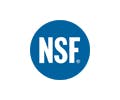NSF International announced that a new national standard has been published to reduce nitrogen from residential wastewater. The focus of the standard is to decrease excess nitrogen from any source that flows into surface waters and stimulates algae formation, a condition that could potentially harm marine life habitat and destroy fish and shellfish populations.
NSF/ANSI Standard 245: Wastewater Treatment Systems – Nitrogen Reduction was developed to address regulatory agencies’ concerns about onsite wastewater systems’ environmental impact. Specifically, this standard addresses the impact these systems have on ground water used as a drinking water source, and on surface waters receiving discharge from the systems.
Nitrite and nitrate in concentrations above EPA’s drinking water standards may present public health problems for infants, pregnant women and populations that may be immunocompromised.
“Communities and their local community leaders sought NSF to provide leadership in helping reduce nitrogen loads to soil, ground water, streams, rivers, lakes and estuaries,” said Dr. Mike Hoover, a professor North Carolina State University who also serves as chair of the NSF Wastewater Technology Joint Committee. “The recent adoption of this new standard will assist health and environmental agencies in doing just that. The standard will enhance public health protection, but still allow people to use their land for development purposes.”
NSF/ANSI Standard 245 establishes performance measures and material, design and construction requirements for residential wastewater treatment systems. Individual residential wastewater treatment systems that meet NSF/ANSI Standard 245 requirements could reduce the amount of nitrogen discharged into surface waters by at least 50 percent in some watersheds, according to Hoover.
The EPA estimates that onsite wastewater systems are used by 25% of all homes in the U.S. and by nearly 35% of new land development. Onsite systems are also used by almost 50% of all people in some states.
"Improved wastewater treatment is one of the most effective ways to reduce nitrogen pollution in water," said Tom Bruursema, general manager, NSF Wastewater Treatment Units Program. “NSF/ANSI Standard 245 establishes requirements that will improve the quality of treated wastewater to help meet the needs of public health and environmental regulators.”
NSF/ANSI Standard 245 was developed based on a protocol developed under the EPA’s Environmental Technology Verification (ETV) Program’s Water Quality Protection. The protocol for nitrogen reduction for residential wastewater treatment systems served as a guide to evaluate six different nitrogen reduction technologies. The new standard incorporates pass/fail criteria for system performance and additional requirements for alarm systems, tank requirements, noise levels and manuals.
Source: NSF International


